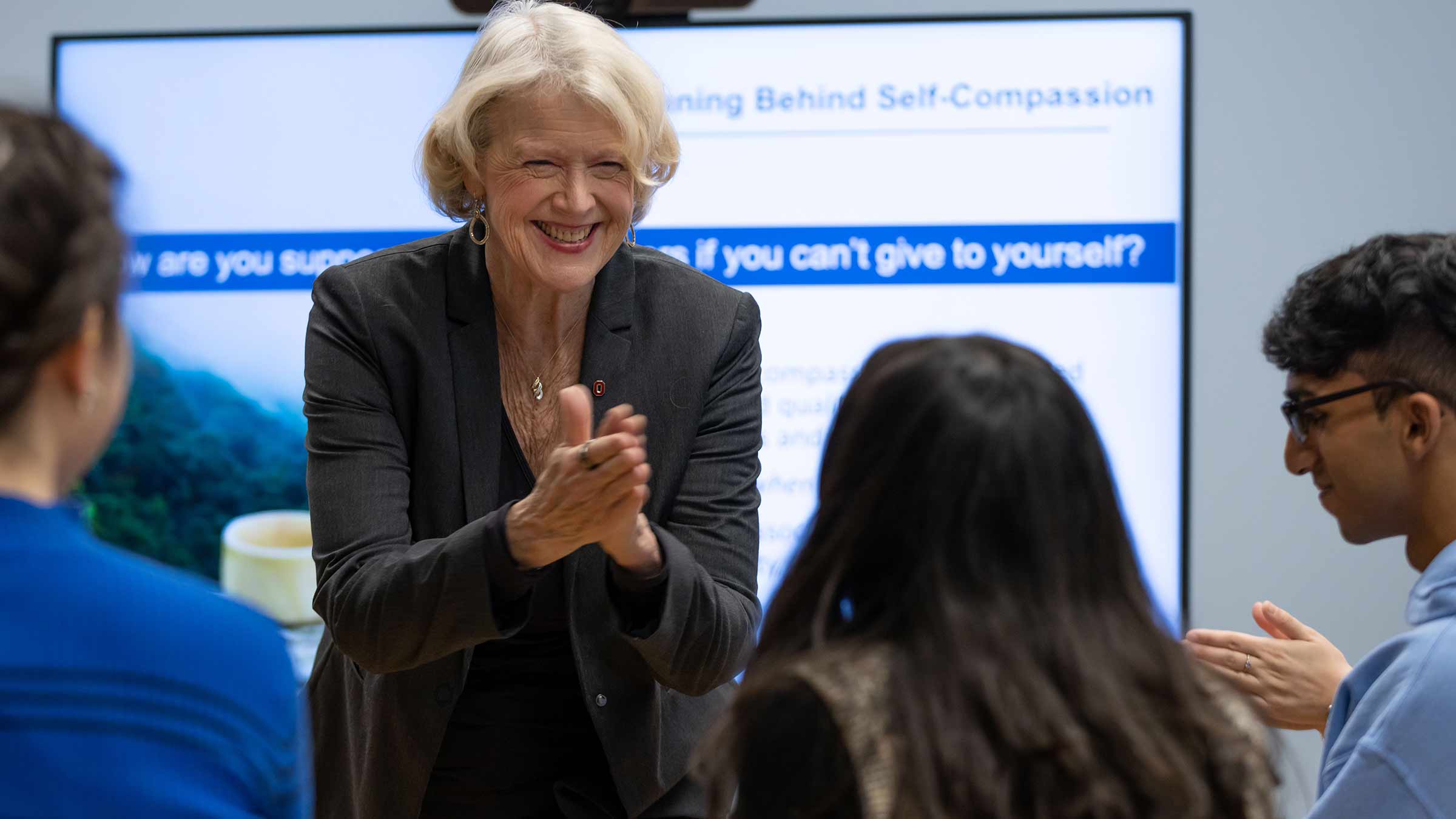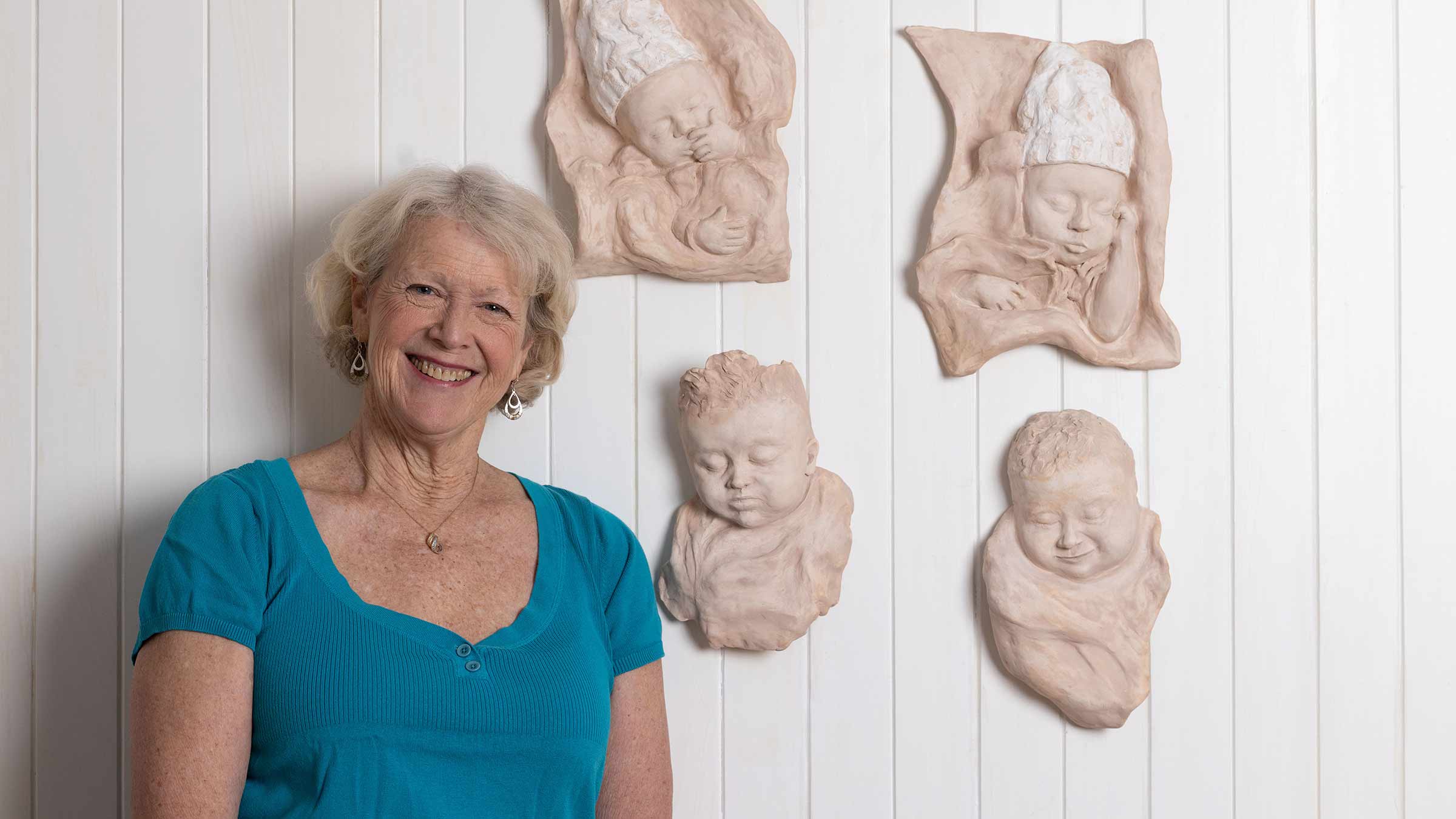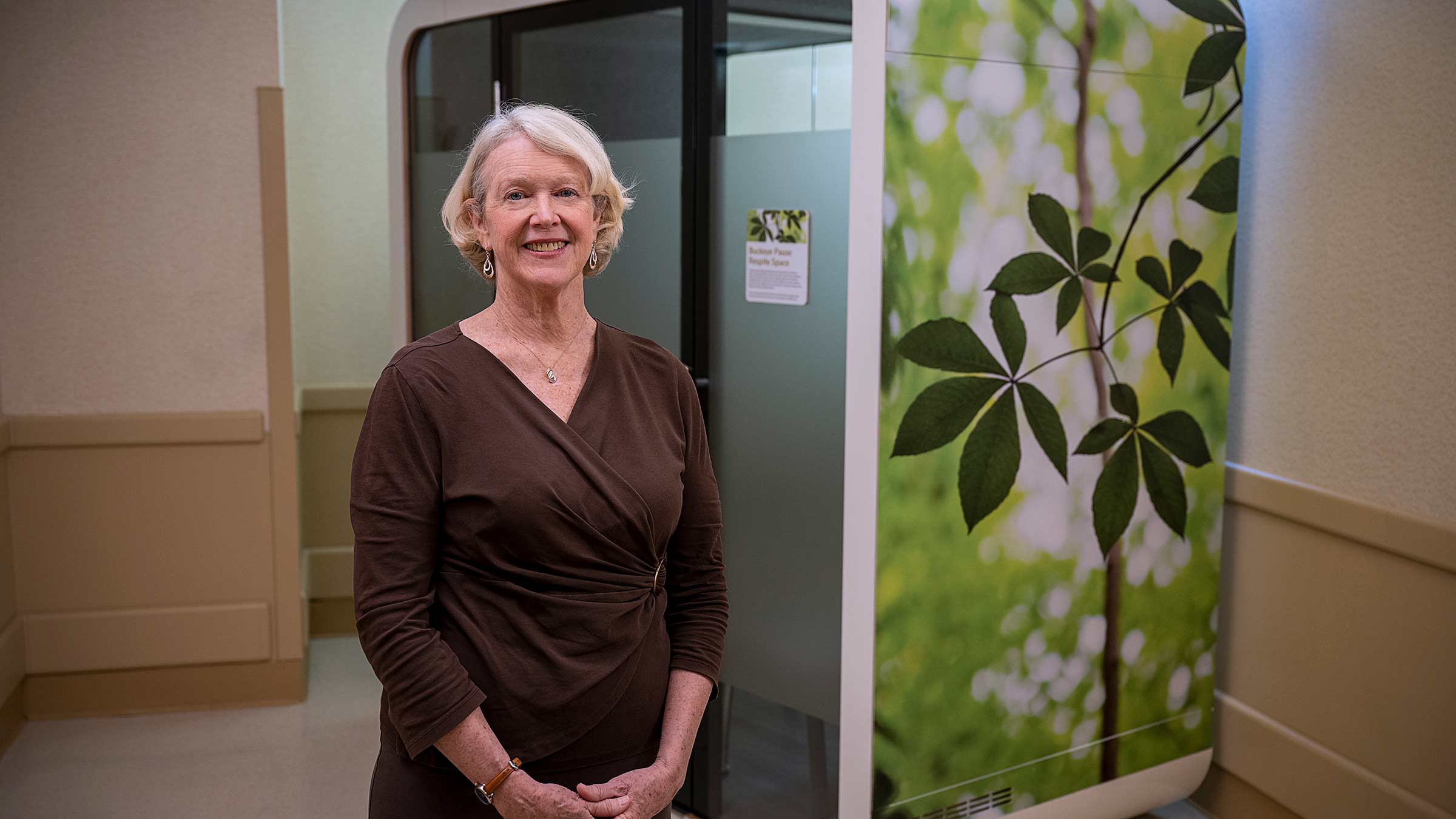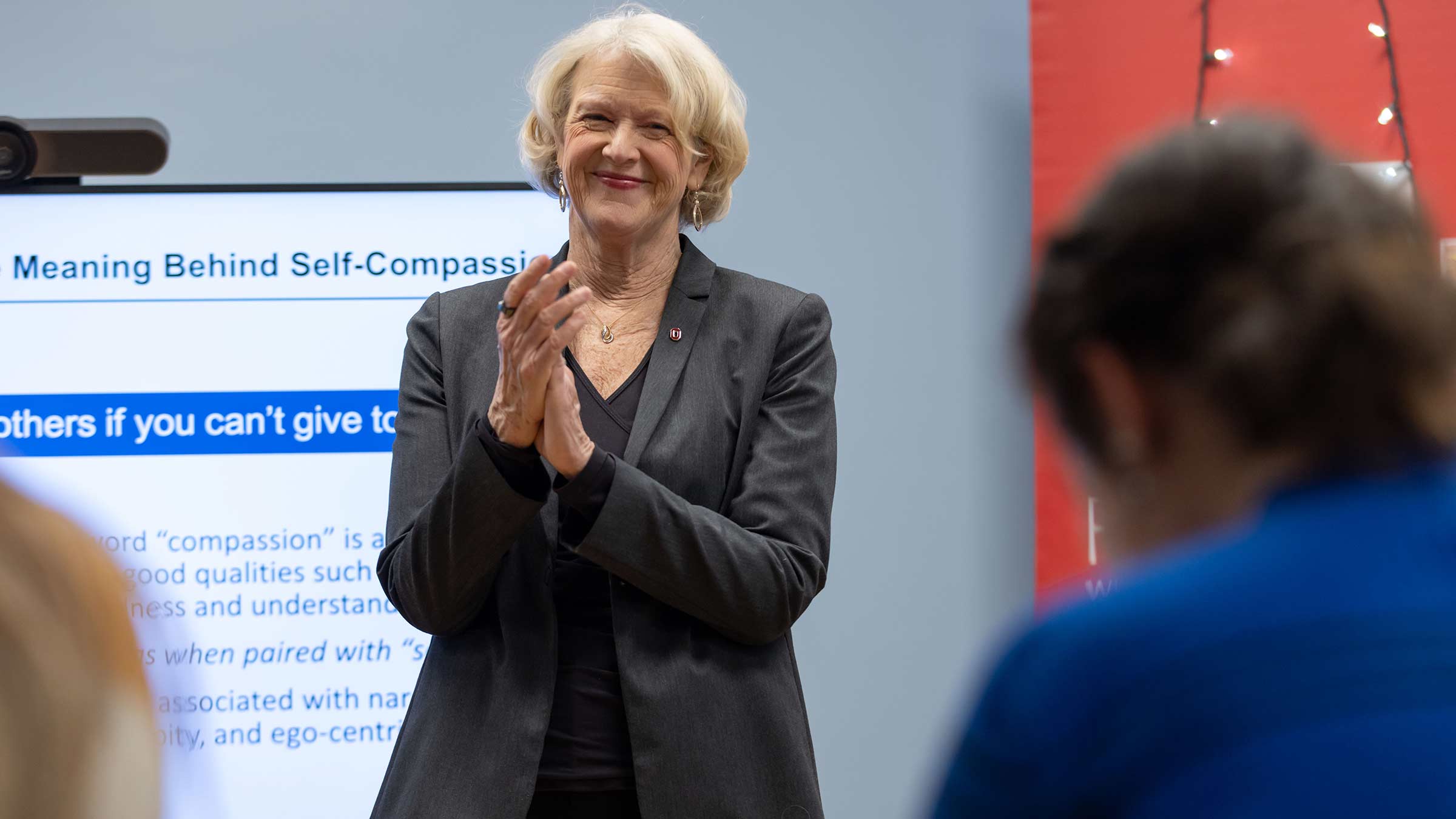Teaching mindfulness to calm caregivers
Long before it was trendy, Maryanna Klatt began guiding people to better ways of dealing with stress
Maryanna Klatt, PhD, steps to the podium and begins her speech with an unexpected request.
“I’m a yoga teacher, so everyone has to stand up.”
That’s a signal to her audience of mostly graduate students that this won’t be like the lectures they get during the week.
Stretching out her arms, she gestures that everyone needs to spread out across the room.
She directs them to stretch their arms up, lift their shoulders up, back and around, and then comes “the really fun part” as Dr. Klatt calls it: She leads them in patting their faces, their cheeks, heads, the back of their heads, chests, “like Tarzan.”
Then they sit back down. The students are on their way to being physical therapists, pharmacists, nurses or other clinicians. They’ve come this morning to learn to become resilient and steer away from burnout in the professions they’re about to begin.
One way is through mindfulness, having your mind fully in a moment as it’s happening rather than in the future (the to-do list) or stuck in the past (“I shouldn't have sent that text”), explains Dr. Klatt, a clinical professor of Family and Community Medicine at The Ohio State University College of Medicine.
“Being mindful is easy to do when things are fun and good,” she says. “But it’s hard to do when it’s stressful, when you have too little time to accomplish all of the things you want or when something happens that’s unexpected that we can’t control.”
For this audience, mindfulness is not a new idea, as it was when Dr. Klatt began teaching it on campus about two decades ago. Back then, some students were skeptical. Still, Dr. Klatt persisted, creating Mindfulness in Motion, an eight-week program on awareness and relaxation techniques that combines weekly group meetings with individual practice. It’s been taught to schoolchildren, police departments, bank employees in Denmark, patients and staff at The Ohio State University Wexner Medical Center and at four other hospitals in the state.
Dr. Klatt is also director of Ohio State Integrative Health, which includes a medical practice offering a range of specialists to heal body, mind and spirit using evidence-based approaches.

Proving the benefits of mindfulness
On campus at Ohio State, Dr. Klatt’s foray into teaching mindfulness began with a yoga class for medical students about 15 years ago. Though it was a required class to help them cope with their heavy workloads, some students were reluctant to participate. Others considered it a Buddhist practice and against their religion.
“My approach was never to try to convince anybody,” Dr. Klatt says. “I think that’s what gave me credibility and the energy to sustain it.”
Blending yoga, stretching and tactics for increasing self-awareness while reducing stress, Dr. Klatt created the Mindfulness in Motion program in 2004. Over the years, her research has revealed that surgical intensive care nurses who took Mindfulness in Motion reduced the release of stress hormones in their bodies by nearly half, university faculty slept better, and cancer survivors and their caregivers became significantly more resilient.

Studying saliva reveals effects of mindfulness on stress hormones
Beth Steinberg, PhD, RN, was supervising critical care nurses at The Ohio State Wexner Medical Center in 2008 when she asked Dr. Klatt for help.
“I have nurses in tears every day. I don’t know what to do,” Dr. Steinberg said.
Could Dr. Klatt teach them mindfulness?
Reluctant at first, Dr. Klatt wondered how her program could make much of a difference for nurses under such a high level of stress, the grief and pressure of caring for — and sometimes losing — critically ill patients every day.
Eventually, at the urging of her mentor, she agreed. And she and Dr. Steinberg gathered data to see if the 32 surgical intensive care employees, mostly nurses, would experience any changes in how they reacted to the everyday challenges at work.
At the time, there was little research showing how meditation and mindfulness can calm the amygdala, the part of the brain that produces stress hormones that can cause someone to feel the impulse to fight, flee or freeze in a difficult situation.
During some sessions, the surgical intensive care employees had to spit into a container to measure an enzyme in their saliva, salivary amylase, an indicator of the stress response in their body. Over the eight weeks of the program, the nurses reduced their cortisol-producing fight-or-flight response by 40%, on average.
“That was yuge,” Dr. Klatt says, showing the first glimpse of a southern Ohio accent she inherited growing up. “We must have recalculated those numbers a thousand times. I kept thinking: How can that be?”
That success fueled her ambition to spread Mindfulness in Motion at the medical center. As medical professionals, many staff members were more accustomed to holding back their feelings than airing them in a group, but Dr. Klatt’s disposition helped draw them out, Dr. Steinberg says.
“Maryanna is a very expressive person. She’s vulnerable. She puts it right out there,” Dr. Steinberg says. “It’s refreshing. It takes away that barrier and people can feel vulnerable with her.”

Finding her niche
Dr. Klatt traces her interest in the mind-body-spirit connection back to a mysticism class she took as an undergraduate psychology major at Kenyon College.
One of her first jobs after college was working as a patient assistant at a hospital burn unit at the University of North Carolina Medical Center. There, she had the challenging job of bathing people, scraping the dead skin from their wounds. Something fascinated her about her patients. Even among those with the same degree of burns, some reacted as if the baths were torture while others seemed to get through them OK.
“Whatever the difference was, I wanted to study that,” she says, rubbing her fingers together as if fingering grains of sand.
She would go on to get a master’s degree in religious studies with an emphasis in medical ethics from the University of Virginia. Then, for over a decade she taught high school theology.
“I always wanted to go into healing, taking care of people somehow, but none of the traditional avenues felt like the right thing exactly,” she says.
She would go on to pursue a doctorate in Leadership in Education. As a gift to herself for finishing her PhD, she took a yoga instructor training course and later a mindfulness class from Jon Kabat-Zinn, PhD, a professor of medicine emeritus at the University of Massachusetts Medical School.
She loved the class except for all the sitting. She needed to move first before she could feel calm. So she created her own program with mindfulness instruction along with stretching, yoga and music, a short piano piece composed by her husband, a recently retired state appeals court judge who dabbles in music.
While teaching the program and working as an assistant professor in Health and Rehabilitation Sciences at Ohio State, Dr. Klatt was doing research that showed different types of health care professionals could benefit from being more resilient and less burned out.
Then COVID-19 hit.

A balm to prevent burnout
During the pandemic, as stress levels soared, particularly in hospitals, Dr. Klatt and her staff went into overdrive.
“While some were at home in their jammies, I was dressed up, wearing makeup. I had never been so busy.”
In a virtual world, YouTube became their way of connecting people to mindfulness. Besides launching videos on relaxation, Dr. Klatt and her staff created an app and an online version of Mindfulness in Motion, all to help people, especially health care professionals, find peace amid the daily storms.
For nurses, doctors and other medical staff, Dr. Klatt pursued and received a grant to pay for soundproof booths at the Ohio State Wexner Medical Center where employees can go for a break to listen to guided meditations.
“She’s taking a global problem — burnout among people who work in a hospital system — and she’s giving people an opportunity in a group setting to learn tools that can be applied to their daily lives,” says Carly Sobol, MD, a graduate of the Ohio State College of Medicine, who took and later taught Mindfulness in Motion at Ohio State.
“Her approach is not simply about helping people become more productive at work or improve patient care, although arguably it can. It’s more than that. Her approach is focused on each person as a human being and the life they’re living beyond the workplace.”

A quickly spreading program
In the past year, four other hospital systems in the state and a community health care organization in Oregon began offering Mindfulness in Motion to their employees. Reaching hospitals nationwide is Dr. Klatt’s ambition.
Closer to home, she’s reaching future health care professionals, having created an undergraduate minor at Ohio State in integrative approaches to wellness. The minor includes courses in yoga theory, behavioral neuroscience and the psychology of creativity. She considers that to be her biggest accomplishment.
“If we can get in early and teach some nonpharmaceutical ways to add to medical treatment, that could change medicine moving forward,” she says. “And for me, that feels like a success.”

When you give to The Ohio State University Wexner Medical Center, you’re helping improve lives
We’re committed to making advancements in research, education and patient care that will have an impact throughout Ohio and the world.
Ways to Give



